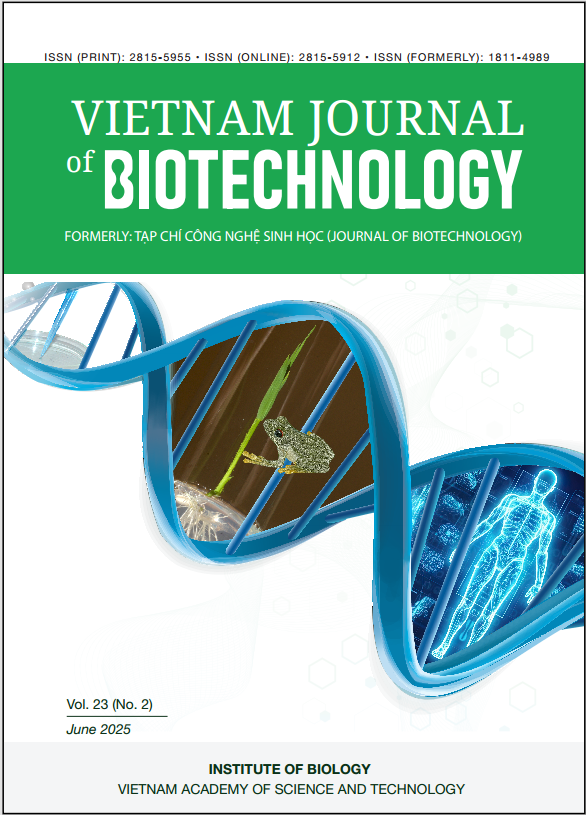Genomic characterization and molecular docking identified a copper amine oxidase involved in Huperzine A biosynthesis in endophytis fungi Daldinia sp.TLC19
Author affiliations
DOI:
https://doi.org/10.15625/vjbt-22299Keywords:
copper amine oxidase, Daldinia sp. TLC19, endophytic fungi, genome annotation, Huperzine A biosynthesis pathway, molecular dockingAbstract
Huperzine A (HupA), a lycopodium alkaloid derived from several species of the Huperzia family and some filamentous fungi, has been studied intensively for decades due to its reversible inhibition of acetylcholinesterase and enhanced cognitive function. In our previous study, nine HupA producing endophytic fungi were isolated from Huperzia javanica, including high yield species Daldinia sp. TLC19 with a HupA concentration of approximately 0.305 mg/g dry cellular weight (dcw). In order to determine the essential genes involved in the HupA biosynthesis pathway in Daldinia sp. TLC19, the whole genome sequencing was performed. Reads were assembled following the Hierarchical Genome Assembly Process (HGAP) method. The genome size was 41 MB and the GC content was about 48.2%. BUSCO analysis revealed high-quality assembly with a completeness score of approximately 98.5% and the repetitive gene ratio of around 0.1%. A putative copper amine oxidase (CAO), which catalyzes the transformation of cadaverine to 5-aminopentanal in the HupA biosynthesis pathway, was determined based on genome annotation with GenBank, the protein domain database and protein secondary structure mapping. In the molecular docking analysis, the binding of cadaverine to topaquinone (autocatalytic oxidation of tyrosine residue 415) at the active site supported the determination of Daldinia sp. TLC19 copper amine oxidase. Our finding on the copper amine oxidase encoding gene of endophytic fungi TLC19 could be used in further research on high HupA producing strain improvement.
Downloads
References
Ariantari, N. P., & Putri, N. W. P. S. (2023). Production of Huperzine a by fungal endophytes associated with Huperziaceae plants. Journal Pharmaceutical Science and Application, 5(1), 45–52. https://doi.org/10.24843/JPSA.2023.v05.i01.p06
Birks, J. S., Chong, L., & Grimley Evans, J. (2015). Rivastigmine for Alzheimer’s disease. The Cochrane Database of Systematic Reviews, 2015(9), CD001191. https://doi.org/10.1002/14651858.CD001191.pub4
Brůna, T., Hoff, K. J., Lomsadze, A., Stanke, M., & Borodovsky, M. (2021). BRAKER2: Automatic eukaryotic genome annotation with GeneMark-EP+ and AUGUSTUS supported by a protein database. NAR Genomics and Bioinformatics, 3(1), lqaa108. https://doi.org/10.1093/nargab/lqaa108
Buchfink, B., Reuter, K., & Drost, H.-G. (2021). Sensitive protein alignments at tree-of-life scale using DIAMOND. Nature Methods, 18(4), 366–368. https://doi.org/10.1038/s41592-021-01101-x
Cantalapiedra, C. P., Hernández-Plaza, A., Letunic, I., Bork, P., & Huerta-Cepas, J. (2021). EggNOG-mapper v2: Functional annotation, orthology assignments, and domain prediction at the metagenomic scale. Molecular Biology and Evolution, 38(12), 5825–5829. https://doi.org/10.1093/molbev/msab293
Cantarel, B. L., Korf, I., Robb, S. M. C., Parra, G., Ross, E., Moore, B., et al (2008). MAKER: An easy-to-use annotation pipeline designed for emerging model organism genomes. Genome Research, 18(1), 188–196. https://doi.org/10.1101/gr.6743907
Chen, X. Y., Qi, Y. D., Wei, J. H., Zhang, Z., Wang, D. L., Feng, J. D., et al (2011). Molecular identification of endophytic fungi from medicinal plant Huperzia serrata based on rDNA ITS analysis. World Journal of Microbiology and Biotechnology, 27(3), 495–503. https://doi.org/10.1007/s11274-010-0480-x
Crismon, M. L. (1994). Tacrine: First drug approved for Alzheimer’s disease. The Annals of Pharmacotherapy, 28(6), 744–751. https://doi.org/10.1177/106002809402800612
Flynn, J. M., Hubley, R., Goubert, C., Rosen, J., Clark, A. G., Feschotte, C., et al (2019). RepeatModeler2: Automated genomic discovery of transposable element families. Genomics. https://doi.org/10.1101/856591
Hoa, T. T., Thu Giang, N., Hong Ha, N. T., Huyen, T. T., Tien Phat, D., Hoang Ha, C., … Ho Quang, T. (2023). Diversity of endophytic fungi from medicinal plants Dysosma difformis (Hemsl & E.H. Wilson) T.H. Wang collected in Ha Giang and Lai Chau. Vietnam Journal of Biotechnology, 21(2), 365–373. https://doi.org/10.15625/1811-4989/18344
Kim, S., Chen, J., Cheng, T., Gindulyte, A., He, J., He, S., et al (2023). PubChem 2023 update. Nucleic Acids Research, 51(D1), D1373–D1380. https://doi.org/10.1093/nar/gkac956
Le, T. T. M., Pham, H. T., Trinh, H. T. T., Tran, H. T., & Chu, H. H. (2023). Isolation and characterization of novel Huperzine-producing endophytic fungi from Lycopodiaceae species. Journal of Fungi, 9(12), Article 12. https://doi.org/10.3390/jof9121134
Li, X., Li, W., Tian, P., & Tan, T. (2022). Delineating biosynthesis of Huperzine A, A plant-derived medicine for the treatment of Alzheimer’s disease. Biotechnology Advances, 60, 108026. https://doi.org/10.1016/j.biotechadv.2022.108026
Ma, X., & Gang, D. R. (2004). The Lycopodium alkaloids. Natural Product Reports, 21(6), 752–772. https://doi.org/10.1039/B409720N
Madeira, F., Madhusoodanan, N., Lee, J., Eusebi, A., Niewielska, A., Tivey, A. R. N., et al (2024). The EMBL-EBI Job Dispatcher sequence analysis tools framework in 2024. Nucleic Acids Research, 52(W1), W521–W525. https://doi.org/10.1093/nar/gkae241
Marucci, G., Buccioni, M., Ben, D. D., Lambertucci, C., Volpini, R., & Amenta, F. (2021). Efficacy of acetylcholinesterase inhibitors in Alzheimer’s disease. Neuropharmacology, 190, 108352. https://doi.org/10.1016/j.neuropharm.2020.108352
Marucci, G., Moruzzi, M., & Amenta, F. (2020). Chapter 31—Donepezil in the treatment of Alzheimer’s disease. In C. R. Martin & V. R. Preedy (Eds.), Diagnosis and Management in Dementia (pp. 495–510). Academic Press. https://doi.org/10.1016/B978-0-12-815854-8.00031-8
Mikheenko, A., Valin, G., Prjibelski, A., Saveliev, V., & Gurevich, A. (2016). Icarus: Visualizer for de novo assembly evaluation. Bioinformatics, 32(21), 3321–3323. https://doi.org/10.1093/bioinformatics/btw379
Mistry, J., Chuguransky, S., Williams, L., Qureshi, M., Salazar, G. A., Sonnhammer, E. L. L., et al (2021). Pfam: The protein families database in 2021. Nucleic Acids Research, 49(D1), D412–D419. https://doi.org/10.1093/nar/gkaa913
Nagakubo, T., Kumano, T., Ohta, T., Hashimoto, Y., & Kobayashi, M. (2019). Copper amine oxidases catalyze the oxidative deamination and hydrolysis of cyclic imines. Nature Communications, 10(1), 413. https://doi.org/10.1038/s41467-018-08280-w
Ngọc, V. T., Hạnh, P. T., Anh, L. T. L., Đạt, N. T., & Thủy, L. T. B. (2016). Qualification and quantification of Huperzine A from Huperia serrata in Da Lat, Lam Dong province. Vietnam Journal of Biotechnology, 14(3), 473–478. https://doi.org/10.15625/1811-4989/14/3/9861
O’Boyle, N. M., Banck, M., James, C. A., Morley, C., Vandermeersch, T., & Hutchison, G. R. (2011). Open Babel: An open chemical toolbox. Journal of Cheminformatics, 3(1), 33. https://doi.org/10.1186/1758-2946-3-33
Parsons, M. R., Convery, M. A., Wilmot, C. M., Yadav, K. D. S., Blakeley, V., Corner, A. S., Phillips et al (1995). Crystal structure of a quinoenzyme: Copper amine oxidase of Escherichia coli at 2 Å resolution. Structure, 3(11), 1171–1184. https://doi.org/10.1016/S0969-2126(01)00253-2
Pettersen, E. F., Goddard, T. D., Huang, C. C., Meng, E. C., Couch, G. S., Croll, T. I., et al (2021). UCSF ChimeraX: Structure visualization for researchers, educators, and developers. Protein Science : A Publication of the Protein Society, 30(1), 70–82. https://doi.org/10.1002/pro.3943
Rahman, A., Banu, Z., Rani, R., & Mehdiya, R. (2024). Unravelling Alzheimer’s disease: Insights into pathophysiology, etiology, diagnostic approaches, and the promise of aducanumab, lecanemab, and donanemab. Journal of Phytonanotechnology and Pharmaceutical Sciences 4(3):1-10, 2024. https://dx.doi.org/10.54085/jpps.2024.4.3.1
Robert, X., & Gouet, P. (2014). Deciphering key features in protein structures with the new ENDscript server. Nucleic Acids Research, 42(W1), W320–W324. https://doi.org/10.1093/nar/gku316
Schöning-Stierand, K., Diedrich, K., Fährrolfes, R., Flachsenberg, F., Meyder, A., Nittinger, E., et al (2020). ProteinsPlus: Interactive analysis of protein–ligand binding interfaces. Nucleic Acids Research, 48(W1), W48–W53. https://doi.org/10.1093/nar/gkaa235
Simão, F. A., Waterhouse, R. M., Ioannidis, P., Kriventseva, E. V., & Zdobnov, E. M. (2015). BUSCO: Assessing genome assembly and annotation completeness with single-copy orthologs. Bioinformatics, 31(19), 3210–3212. https://doi.org/10.1093/bioinformatics/btv351
Thai, Q. K., Huynh, P., Nguyen Thi Thuong, H., & Quan, Q.-D. (2023). Investigating the impact of spike protein mutations on SARS-CoV-2 virulence in benin using network centrality and molecular docking approaches. Vietnam Journal of Biotechnology, 21(2), 219–234. https://doi.org/10.15625/1811-4989/18276
Thi Minh Le, T., Thi Hong Hoang, A., Thi Bich Le, T., Thi Bich Vo, T., Van Quyen, D., & Hoang Chu, H. (2019). Isolation of endophytic fungi and screening of Huperzine A–producing fungus from Huperzia serrata in Vietnam. Scientific Reports, 9(1), 16152. https://doi.org/10.1038/s41598-019-52481-2
Torrance, J. W., Holliday, G. L., Mitchell, J. B. O., & Thornton, J. M. (2007). The geometry of interactions between catalytic residues and their substrates. Journal of Molecular Biology, 369(4), 1140–1152. https://doi.org/10.1016/j.jmb.2007.03.055
Waterhouse, A., Bertoni, M., Bienert, S., Studer, G., Tauriello, G., Gumienny, R., et al (2018). SWISS-MODEL: Homology modelling of protein structures and complexes. Nucleic Acids Research, 46(W1), W296–W303. https://doi.org/10.1093/nar/gky427
Xuan Cuong, H., Minh Thuong, V., Nhu Binh, D., Duc Tien, D., Thuy Linh, B., & Bich Thuy, V. T. (2023). Prediction of conservative epitopes in the NS1 sequences of all four dengue virus serotypes. Vietnam Journal of Biotechnology, 21(3), 443–454. https://doi.org/10.15625/1811-4989/18423
Yang, H., Peng, S., Zhang, Z., Yan, R., Wang, Y., Zhan, J., et al (2016). Molecular cloning, expression, and functional analysis of the copper amine oxidase gene in the endophytic fungus Shiraia sp. Slf14 from Huperzia serrata. Protein Expression and Purification, 128, 8–13. https://doi.org/10.1016/j.pep.2016.07.013
Zhang, G., Wang, W., Zhang, X., Xia, Q., Zhao, X., Ahn, Y., et al (2015). De novo RNA sequencing and transcriptome analysis of Colletotrichum gloeosporioides ES026 reveal genes related to biosynthesis of Huperzine A. PLOS ONE, 10(3), e0120809. https://doi.org/10.1371/journal.pone.0120809
Zhang, H. (2012). New insights into Huperzine A for the treatment of Alzheimer’s disease. Acta Pharmacologica Sinica, 33(9), 1170–1175. https://doi.org/10.1038/aps.2012.128
Zhang, X., Wang, Z., Jan, S., Yang, Q., & Wang, M. (2017). Expression and functional analysis of the lysine decarboxylase and copper amine oxidase genes from the endophytic fungus Colletotrichum gloeosporioides ES026. Scientific Reports, 7(1), 2766. https://doi.org/10.1038/s41598-017-02834-6
Zhang, Z. B., Zeng, Q. G., Yan, R. M., Wang, Y., Zou, Z. R., & Zhu, D. (2011). Endophytic fungus Cladosporium cladosporioides LF70 from Huperzia serrata produces Huperzine A. World Journal of Microbiology and Biotechnology, 27(3), 479–486. https://doi.org/10.1007/s11274-010-0476-6
Zhu, D., Wang, J., Zeng, Q., Zhang, Z., & Yan, R. (2010). A novel endophytic Huperzine A–producing fungus, Shiraia sp. Slf14, isolated from Huperzia serrata. Journal of Applied Microbiology, 109(4), 1469–1478. https://doi.org/10.1111/j.1365-2672.2010.04777.x







